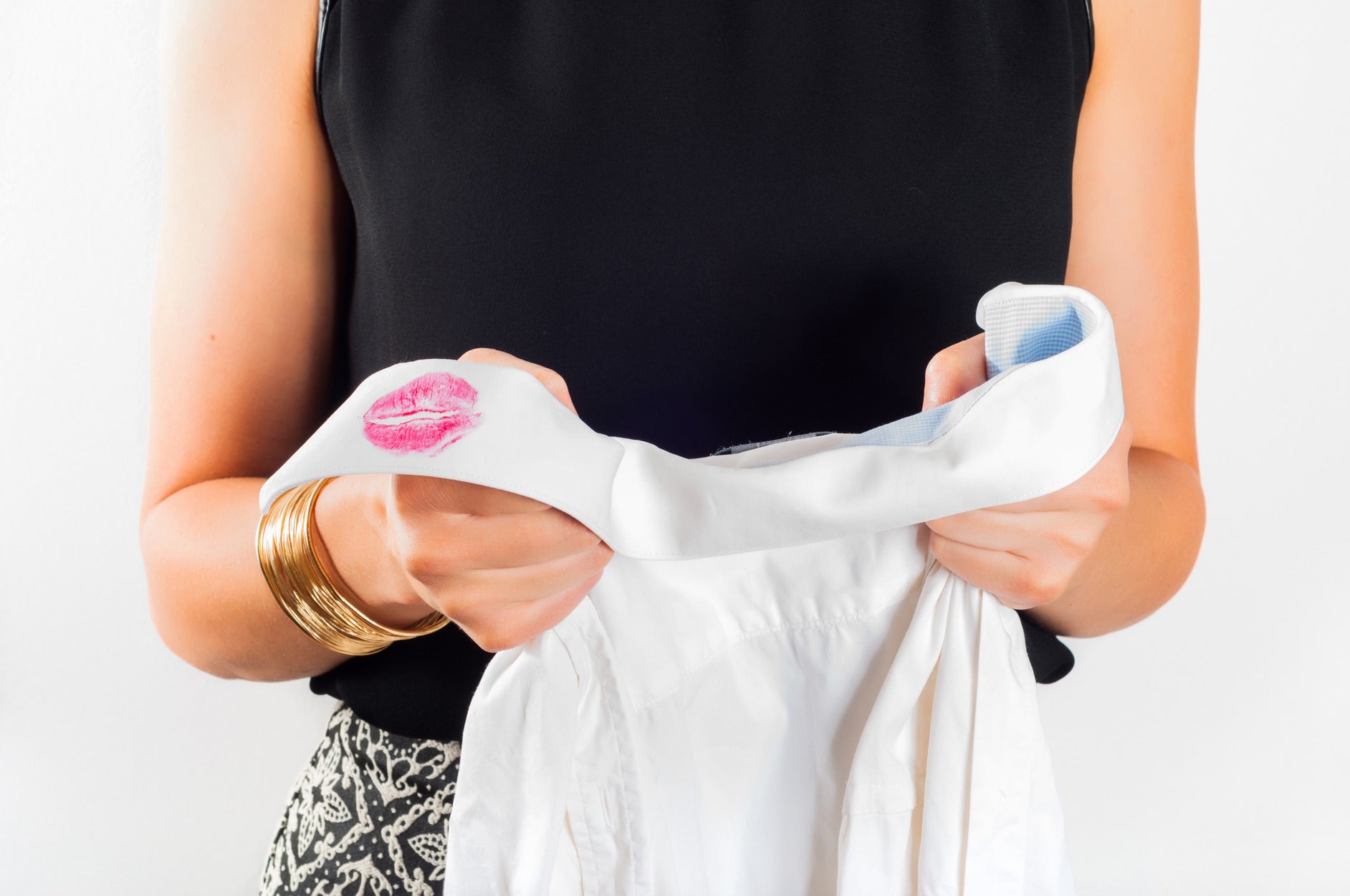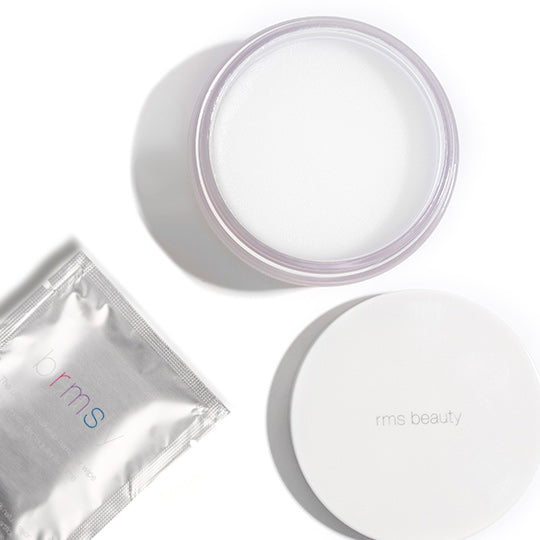Easy Solutions To Remove Lipstick From Clothes

Your favorite shade of iconic red looks amazing on your lips, and less amazing on your crisp white button down. Even the most careful among us can’t avoid a lipstick incident from time to time, and with cloth masks now an essential we never leave home without, you can count on treating occasional lipstick stains more than you’d normally need to.
While a quick Google search will net you a few lipstick removal tips, the solutions that work come from beauty insiders who are familiar with the ingredients in your lip color that cause stains to set and become difficult to remove.
The expert team at RMS Beauty pooled our decades of experience working with lip color products of all kinds to deliver you what actually works in terms of lipstick stain removal, and what you can do to lessen the chance of getting a lipstick stain in the first place.
We’ll give you the inside scoop on what’s actually staining your clothes, how to effectively remove it, and what to avoid so you don’t make it worse.
What’s in lipstick that causes it to stain fabric?
Why is a product that slides off easily with cleanser so stubborn on your fabrics? The reason is because your lips have a protective covering called the stratum corneum, which acts like a barrier between the innermost portions of the skin of your lips and anything in your environment that comes in contact with them (including lipstick).
Fabrics, unless they are treated with stain resistant chemicals, lack that protection, so when you accidentally smudge the cuff of your sleeve against your mouth, that gorgeous, vivacious pink that gives you the perfect pout penetrates deep into fabric fibers, causing a stain.
More precisely, the ingredients that make up your favorite petal pink are to blame for a fabric stain. Lipsticks typically contain three main ingredients:
1. Waxes. Lipsticks contain waxes to make them smooth and help them glide on easily. Many lipsticks contain a blend of synthetic waxes and coloring (such as paraffin or microcrystalline, both derived from petroleum) which can cause a more aggressive stain.
Alternatively, lipsticks that contain naturally-derived wax blends (like beeswax, carnauba wax, and/or candelilla wax) usually produce a spot that is more easily removed from fabrics.
2. Oils. The oil content of lipstick exists to hydrate your lips and keep them moisturized. Although the skin of your lips is similar in structure to the skin on the rest of your body, it lacks sebaceous glands, which means it’s up to your products to keep them hydrated.
Some oils stain your clothing worse than others. For instance, mineral oil, a derivative of petroleum, can be nearly impossible to remove completely from your clothing.
Less invasive to your fabrics and more hydrating than a petroleum-based oil are seed and fruit extracted oils, like jojoba and castor.
3. Pigments. What makes your favorite shade your favorite shade are the proprietary pigment blends found in your lipsticks. These blends range from synthetic colors derived from coal tar (usually labeled as either FD&C or simply D&C in the product ingredient list, to mineral pigments and food-grade dyes found in better quality products.
Synthetic colors can sometimes be impossible to remove.
All three of these ingredients have the potential to stain your clothing, or at the very least the inside of your favorite cloth masks. Before you render the garment useless or repurpose it into a cleaning rag, try these lipstick stain-removing solutions from the pros.
Easy At-Home Solutions To Remove Lipstick Stains From Clothes
When approaching a lipstick stain, you should aim to use a method that specifically works to remove one of the three main offending ingredients.
Keep in mind that because lipsticks usually contain all three ingredients, you’ll likely need to use more than one method to completely lift the stain. Make sure you treat the stain as soon as you notice it. Time isn’t your friend when it comes to stains.
-
Wax removal. Solvents work best for removing wax. A solvent is simply a substance that can dissolve (and remove) another substance. Examples of solvents are water, vinegar, detergent, alcohol, and dish soap.
-
Oils, degreasers, and detergents. Degreasers are solvents specifically designed to remove oil and grease. For lipstick stains, even a mild detergent or shampoo can act as a degreasing agent.
-
Pigments. Pigment removal can be difficult, especially if the pigment is made of synthetic colors. If the pigment is left once you’ve treated the stain with a solvent and/or degreaser, you may need a special oxidant cleaner.
As a side note, you’ll almost always need to launder the stained garment after treating the stain, so be ready to toss it in the wash once you’ve tried one of the below stain removal techniques.
Additionally, you’ll want to avoid using hot water to treat stains, as this can cause the stain to set.
In most cases, you’ll also want to avoid scrubbing the stain, as that can make it worse and cause it to spread. Remember, dab it and blot it, don’t smear it.
Dish Soap
What You’ll Need: Clear, mild dish soap or all purpose cleaner (like Dr. Bronner’s), towel, clean paper towels.
Method: Place your garment stain-side down on a protected surface. Pour a dime size amount of dish liquid to the stain and allow it to soak for ten to fifteen minutes. Turn the garment over and blot (don’t rub or scrub) the stain with a clean paper towel.
Why It Works: Mild dish soap is a great solvent, which can help remove wax and pigments from your garments. Dish soap also works great to eliminate grease on dishes, which makes it effective in removing oils from lipstick-stained garments.
Hair Spray
What You’ll Need: Hairspray containing alcohol, clean paper towels.
Method: Spray the hairspray on the stain and blot with a paper towel.
Why It Works: If you’re in a pinch and want to remove a stain quickly, on-the-spot, a hairspray that contains alcohol can help dissolve the stain. Some hair sprays don’t contain alcohol because it can be drying to your hair. If your hairspray doesn’t contain alcohol, it won’t be effective in stain removal.
Rubbing Alcohol
What You’ll Need: Isopropyl alcohol (or even hand sanitizer if you’re on the go), clean paper towels, or cotton balls.
Method: Using a paper towel or cotton ball blot the alcohol on the stain until it lifts. Follow up with a little cold water on the stain.
Why It Works: Alcohol is a solvent for many substances, and is excellent at removing not only wax and pigment, but also oil.
*Pro tip: At your favorite holiday soiree and end up with lipstick on your clothing? Grab a little clear vodka and dab it on the stain. Follow up with an ice cube and you may be able to spare your shirt (and save face).
Nail Polish Remover (Acetone)
What You’ll Need: Acetone nail polish remover, cotton swabs, a clean toothbrush, clean cloth or paper towels.
Method: Using a cotton swab, dab a small amount of nail polish remover on the stain. Tap the stain with the clean toothbrush, but avoid scrubbing too hard. Blot with a clean cloth or paper towel.
Why It Works: Acetone is a known solvent which can be beneficial in removing some types of pigments, but be warned: it can also cause colors to bleed. Additionally, you’ll never want to use nail polish remover on fabrics which contain acetate. Some synthetic silks and wool fabrics contain acetate, so be sure to read the label.
Petroleum Jelly
What You’ll Need: Petroleum jelly
Method: Using your finger, apply a thin layer of petroleum jelly to the stain and then launder as usual. Inspect the garment after you remove it from the wash. If the stain is still visible, repeat the process or use a different method. Do not dry the garment in the dryer, as this can permanently set it.
Why It Works: Petroleum jelly is good at lifting pigments from garments, but be careful not to over apply it as it can create a difficult to remove stain itself.
Lemon Juice & Baking Soda
What You’ll Need: Lemon juice, baking soda, a clean cloth
Method: Mix equal parts lemon juice and baking soda until you’ve formed a paste. Rub the paste onto the stain and allow it to sit for half an hour. After a half hour, check to see if the stain has been lifted. If not, you can use a clean, soft-bristled brush (on non-delicate fabrics) to scrub the stain.
Why It Works: Lemon juice and baking soda can break down stains that have set in. If you have a stain that you didn’t notice immediately, lemon juice and baking soda can help.
Shaving Cream
What You’ll Need: Shaving cream (foam-based, not gel)
Method: This is mostly a method used for pretreating a garment you’ll likely be able to just launder for efficient stain removal. Dab shaving cream on the stain and blot it on the stain. Launder as usual.
Why It Works: The soapy solvent ingredients in shaving cream make it an option for removing a stain, especially if you don’t have dish soap or other solvents on hand.
Final Tips for Getting That Stain Out
It’s rare you’ll wind up with a stain that can’t be removed if you simply avoid synthetic, petroleum-based lipsticks and opt instead for natural lipsticks, like the ones here at RMS Beauty.
RMS Beauty’s lipstick is removed easily from fabric with a simple cleanser, detergent, mild dish soap or hair shampoo. In fact, our founder Rose-Marie went to a holiday party a few years ago, and the host freaked when he saw her wipe her mouth with her red RMS lipstick into his antique linen napkin. To his shock, it completely came out of the linen with a simple wash. That’s the power of natural ingredients, and you better bet we stick behind ours!
You can also avoid stains by choosing a matte lip color or even a tinted balm. The matte color will be more difficult to transfer onto your fabrics, and the balm will remove easily if it comes in contact with your shirt.
When applying your lip color, less is more. Less layers, and a shorter wear chain will still be effective on your lips without risking your clothing.
If you’re not at home, consider popping by the store to pick up a Tide-To-Go or other stain removal pen so you can treat the stain before you get home.
Dealing with mask stains on a pretty frequent basis? Consider wearing a mask that isn’t as tight against your face. Blot your lipstick with powder or a tissue prior to putting on your mask, which can help you avoid stains.
Some lipstick stains aren’t removable, but you can definitely give your clothes and masks a fighting chance by opting for lip colors that contain natural ingredients that are easily removed with soap and water.
This information for RMS was fact checked by an expert in the beauty industry: Rose-Marie Swift
Sources:
https://www.ncbi.nlm.nih.gov/books/NBK470464/
https://cosmeticsinfo.org/ingredient/synthetic-wax
http://www.beautytruth.com/toxic-ingredients
https://www.presscleaners.com/blog/how-to-get-lipstick-out-of-clothes/




